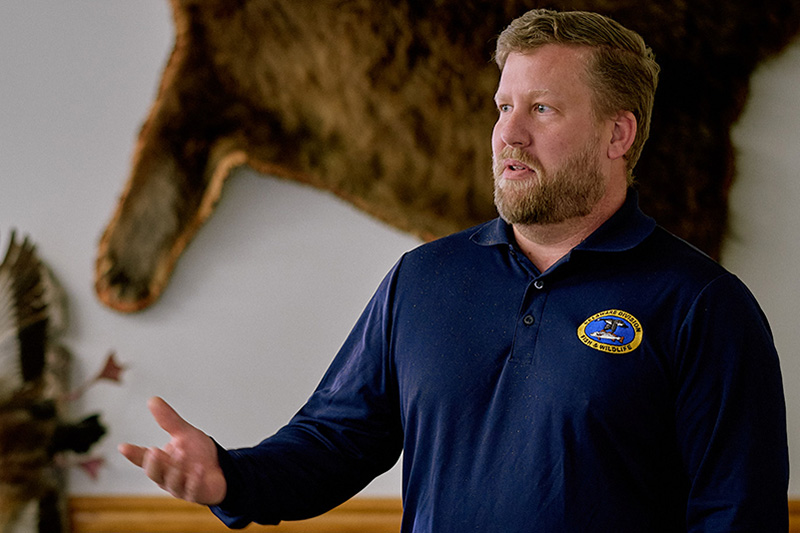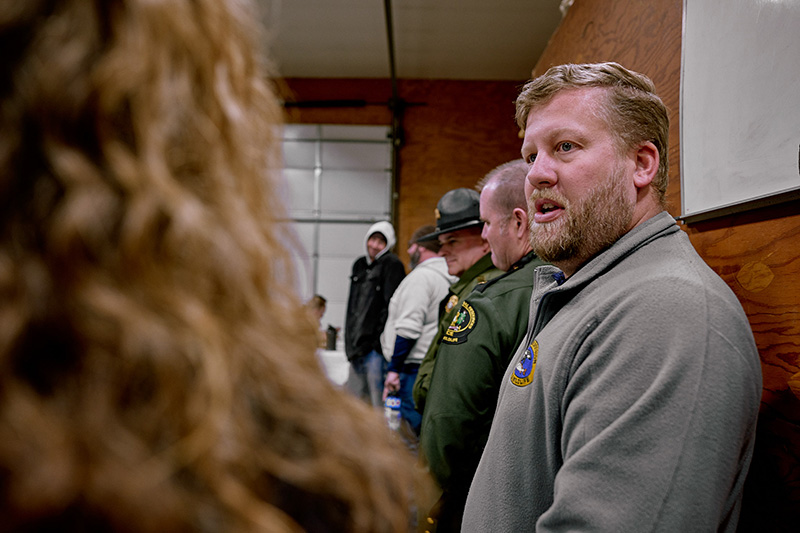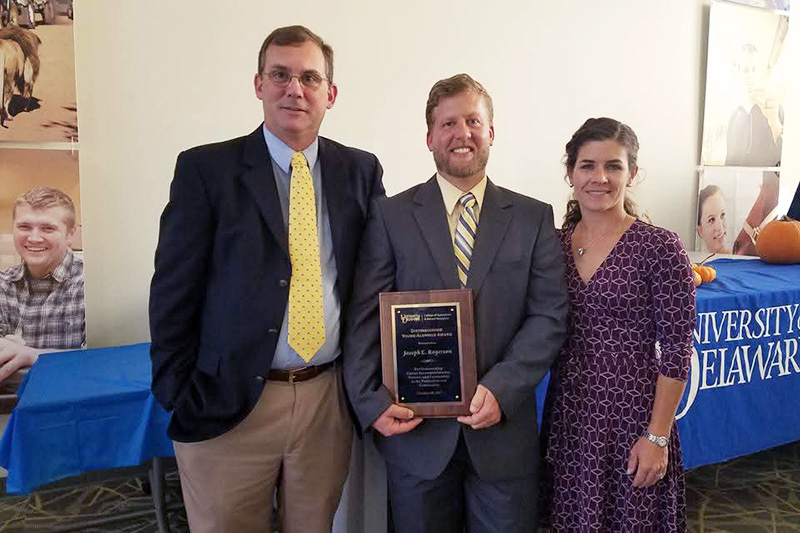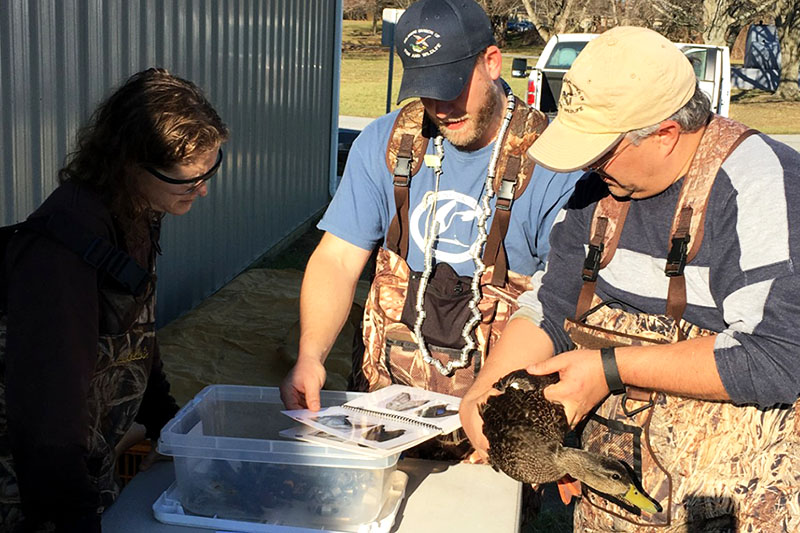


Conserving Delaware’s wildlife
Photos courtesy of the Department of Natural Resources and Environmental Control (DNREC) and Joe Rogerson May 08, 2025
UD alumnus Joe Rogerson leads wildlife conservation and management for the state of Delaware
Joe Rogerson couldn’t wait to start his graduate studies at the University of Delaware. The wildlife ecology alumnus skipped his college graduation to jump-start his graduate fieldwork.
“A day or two after my final exam, I was in Newark, ready to get started,” said Rogerson, now the wildlife section administrator for Delaware’s Department of Natural Resources and Environmental Control (DNREC) Division of Fish and Wildlife.
Rogerson was interested in deer and came to the College of Agriculture and Natural Resources (CANR) to study with Jake Bowman, a professor of wildlife ecology and current chair of the Department of Entomology and Wildlife Ecology. Bowman is known for his research into the Cervidae, or deer family. Rogerson spent the summer in a field assessing the impacts of whitetail deer browsing on soybean yield.
In 2005, Rogerson was the first UD student to earn an M.S. in wildlife ecology. He said his time at UD helped crystallize his career path in conservation.
“Instead of doing research, I was interested in taking the research findings and data and putting them into action,” Rogerson said.
That is exactly what Rogerson has done. His work encompasses everything from migrating shorebirds to interloping black bears.
After graduation, Rogerson started his career as a wildlife biologist for the U.S. Department of Agriculture Animal and Plant Health Inspection Service (APHIS). A year later, he accepted his dream job, serving as Delaware's deer and furbearer project leader with DNREC. He spent a decade in the position before moving on to program manager for species conservation and research. The role took Rogerson to Capitol Hill, where, in 2019, he testified at the Environment and Public Works Committee hearing on invasive species.
In 2024, Rogerson was promoted to wildlife section administrator. He now oversees 60 full-time employees, including wildlife biologists, habitat managers and seasonal biological aides. He plans to align these different teams in an effort to bolster threatened species.

Rogerson is currently working with a team of collaborators to develop the crucial 2025 to 2035 Delaware Wildlife Action Plan. Known as “the blueprints for conserving our nation’s fish and wildlife,” each state’s plan identifies species in the greatest conservation need (SGCN).
“We’re asked to determine the threats impacting those species and their habitats — and what actions could reverse or alleviate the problems,” Rogerson said.
The plans are reviewed every 10 years to be eligible for federal funding.
“The wildlife action plan is the guiding document for our agency,” Rogerson said. “But if you’re a landowner, a forest management agency or anyone interested in conservation, the plan offers recommendations on how you can help,” Rogerson said.
And help is needed.
“Delaware may be the second smallest state, but we have more than 2,300 species,” Rogerson said. “Many of them are small: microinvertebrates or insects, and sadly, 689 are species of greatest conservation need.”
These species include the barking tree frog, red knot, bog turtle, northern long-eared bat and Delmarva fox squirrel, a sub-species of fox squirrel found only on the Delmarva Peninsula. This unique squirrel was among the first species listed under the Endangered Species Act in 1967. Thanks to conservation efforts, it was removed from the list in 2015 but remains rare in Delaware, where the species is endangered at the state level.
“Over the last five years, we’ve worked collaboratively with the Maryland Department of Natural Resources and the U.S. Fish and Wildlife Service,” Rogerson said. “We’ve brought in more than one hundred squirrels as we try to recover the species throughout the state of Delaware.”
The project is a good example of active wildlife management, restoration conservation work, and state and federal partnerships. Delaware state parks, the U.S. Department of Agriculture Forest Service, and private landowners have offered land for fox squirrel reintroduction.

Rogerson was on hand when another of Delaware’s rare species made its first appearance. On a call to assess damage to bee hives, Rogerson observed an unforgettable paw print.
“It was perfect fresh soil, and I could see bear tracks as plain as day,” Rogerson said. “There was no doubt about it.”
The tracks belonged to the first “Delabear,” although you won’t catch Rogerson anthropomorphizing the celebrity black bears, nicknamed Delabear by the media.
While black bears are not a threatened species, they are an uncommon sight in the First State. As populations in surrounding states increase, young male bears disperse further in search of home ranges and territories and, on rare occasions, venture into Delaware.
“These bears are coming into our state in our most densely populated area,” Rogerson said. “This animal doesn’t know how to traverse the landscape and avoid threats like roadways.”
The most recent Delabear died after being hit by a truck, breaking the hearts of hundreds of fans hungry for hourly reports of his hijinks. Previous Delabears, finding our state devoid of potential mates, have wandered back across state lines.
“Until we have females, which don’t disperse as far into Delaware and have the potential for reproduction in the state, we won’t have a viable population,” Rogerson explained.
To Rogerson, that’s a good thing.
“We have habitat that can support bears, but socially, is the state ready to have bears?” noted Rogerson. “That is an issue of greater complexity.”
Advice for future wildlife conservationists
Rogerson fondly remembers his time at UD. Not only did it launch his career, but it’s also where he met his wife, Alison Rogerson, a fellow wildlife ecology graduate student. The UD alumna is now an environmental scientist working with DNREC’s Division of Watershed Stewardship with the wetland monitoring assessment program.
Rogerson has advice for UD students who are hoping to follow in his career footsteps.
“We all have to start by getting our foot in the door one way or another, whether through volunteer opportunities, paid internships, seasonal work or assisting a graduate student,” Rogerson said.

According to Rogerson, the wildlife field is competitive, but field experience can set you apart. It shows employers your initiative to expand your knowledge base and ability to work in field conditions.
“Experiences like helping a grad student, doing bird surveys with [UD faculty member] Greg Shriver, or helping Professor Bowman with a deer project," Rogerson said. "You’ll be doing surveys and research, often in harsh conditions. Maybe it’s July, it’s 95 degrees out, and the mosquitoes are biting, or maybe it’s wintertime.”
The thrill of the unexpected is part of the job.
“You never know what you're going to be doing from one day or month to the next,” Rogerson said. “That's an example of what is exciting and unique about this field; it will keep you on your toes.”
Contact Us
Have a UDaily story idea?
Contact us at ocm@udel.edu
Members of the press
Contact us at mediarelations@udel.edu or visit the Media Relations website

